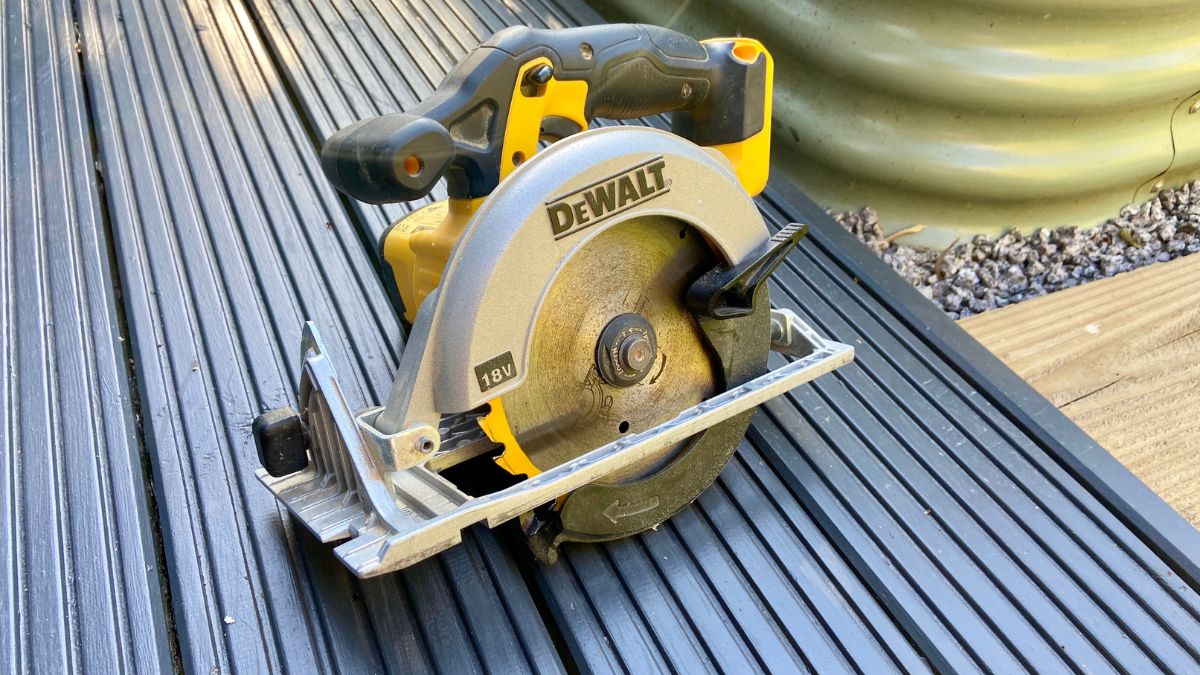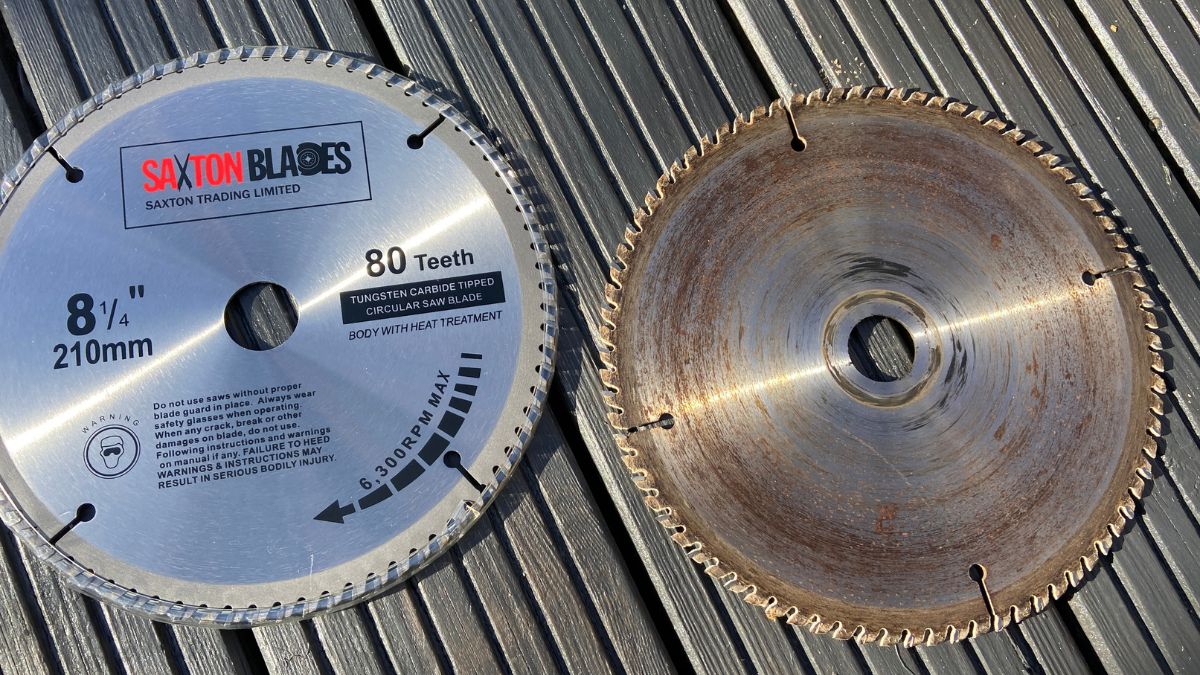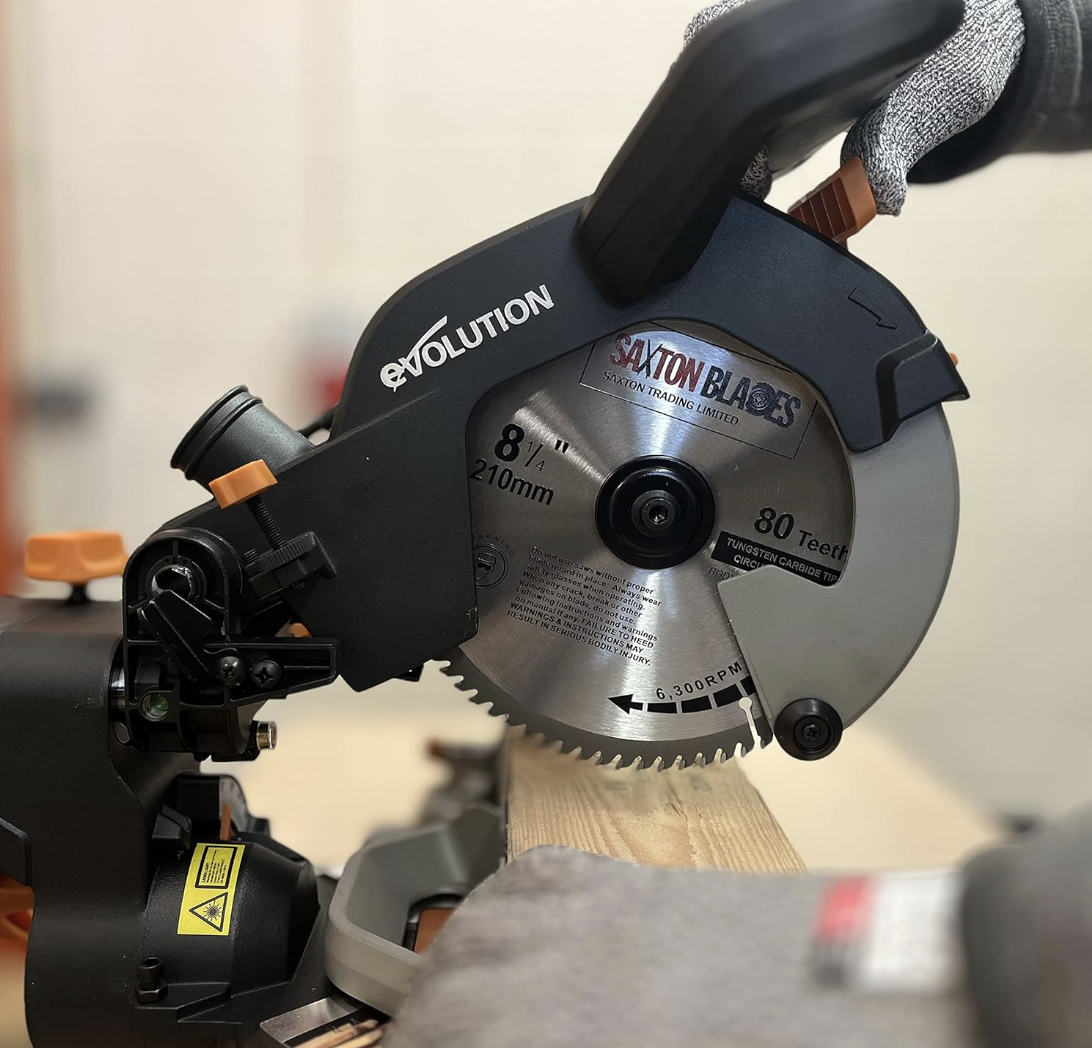A circular saw or mitre saw is an essential tool for many woodworking, construction, and DIY projects. To get the best performance and results, it’s crucial to choose the right blade. I always purchase additional blades for my saws so that I can select the perfect blade for the type of work I’m doing. The correct blade ensures clean cuts, maximises efficiency, and prolongs the life of your saw. Here’s a guide to help you select the right blade for your circular saw.

Understand the Basics of Circular Saw Blades
Circular saw blades come in various sizes and types, designed for different materials and cutting applications. The key factors to consider when selecting a blade include:
- Diameter: The size of the blade, which must match the specifications of your circular saw. You can find your blade diameter printed on the side of your existing saw blade. If this isn’t ledgable any more you can find the information on the saw manufacture’s website. Alternatively you can measure the length from the top of one tooth, to the opposite tooth through the centre of the blade.
- Bore or Arbor Size: The hole in the blade’s centre, which fits onto the saw’s bore. Ensure compatibility with your saw’s bore size. Likewise the bore size can be measured or fouind on the manufacture’s website.
- Teeth: The number and type of teeth determine the quality and speed of the cut.
The Impact of Tooth Count on Cutting Performance

The number of teeth on a circular saw blade significantly affects the quality and type of cut it can make. Here’s a breakdown of how tooth count influences cutting performance and what each range is best suited for:
High Number of Teeth
- Smooth, Clean Cuts: Blades with a high number of teeth (typically 60 to 100) produce smoother and cleaner cuts. This is because the smaller gaps between teeth and the higher tooth count reduce tear-out and splintering.
- Fine Finishing: These blades are ideal for fine woodworking and finishing work where precision and a clean edge are crucial.
- Best For: High-tooth-count blades excel at cutting plywood, veneer, and fine trims. They are also suitable for crosscutting hardwoods and softwoods, providing a polished finish with minimal rough edges.
Low Number of Teeth
- Faster, Rougher Cuts: Blades with a low number of teeth (typically 14 to 24) remove more material with each pass, resulting in faster cuts. However, this can lead to a rougher finish with more tear-out and splintering.
- Efficient Material Removal: These blades are designed for rapid cutting, making them efficient for tasks where speed is more important than a smooth finish.
- Best For: Low-tooth-count blades are ideal for ripping lumber (cutting along the grain) and general-purpose construction work. They are well-suited for cutting through thick, dense materials where a smooth finish is less critical.
Choosing the Right Tooth Count
When selecting a blade, consider the nature of your project and the desired finish. Use high-tooth-count blades for projects requiring fine, detailed cuts, and low-tooth-count blades for faster, rougher cuts through tougher materials. This way, you can ensure both efficiency and quality in your work.
If you are working with timber for a construction job, a low tooth count should be fine. The standard blade on a mid-range mitre saw will likely be a 24-Tooth Multi-Material TCT Blade. This is fine for general use.
If you’re looking for some finer cuts, like I did with this outdoor sofa build, then you should expect to use something like this 80 tooth Saxton TCT Mitre Saw Blade (210mm x 80T x 25.4mm Bore.)

Types of Circular Saw Blades
Different materials and cutting tasks require specific types of blades. Here are some common blade types:
- Rip Blades: Designed for cutting along the grain of the wood (ripping). They have fewer teeth (typically 14-24), which allows for faster, rougher cuts.
- Crosscut Blades: Made for cutting across the grain. These blades have more teeth (60-80), resulting in smoother, cleaner cuts.
- Combination Blades: These versatile blades can handle both ripping and crosscutting. They usually have around 40-50 teeth.
- Plywood Blades: Specialized for cutting plywood and other sheet materials, these blades have many fine teeth (80-100) to prevent splintering.
- Metal Cutting Blades: For cutting metal, these blades are made from or coated with materials like carbide to withstand the hardness of metals.
- Masonry Blades: Used for cutting brick, concrete, and other masonry materials. These blades are typically diamond-tipped to handle the abrasive nature of these materials.
Consider the Tooth Configuration

The tooth configuration affects the blade’s cutting performance and the finish of the cut. The three main configurations are:
- Flat-Top (FT): Teeth are flat on top and best for ripping hardwoods.
- Alternate Top Bevel (ATB): Teeth alternate between left and right bevels, making them excellent for crosscutting and reducing splintering.
- Triple Chip Grind (TCG): Combines a flat-top tooth followed by a trapezoidal tooth, ideal for cutting hard materials like laminates and plastics.
Material of the Blade
The material of the blade impacts its durability and performance. The common materials include:
- High-Speed Steel (HSS): Durable and inexpensive, good for general-purpose cutting.
- Carbide-Tipped: More expensive but stays sharp longer, excellent for frequent use and harder materials.
- Diamond: Ideal for cutting hard and abrasive materials like tile and concrete.
Match the Blade to the Material
Choosing the right blade for the material you are cutting is crucial for optimal performance, efficiency, and safety. Different materials require specific blade characteristics to ensure clean cuts and prolong the blade’s lifespan. Here’s a detailed guide to help you select the appropriate blade for various materials:
Wood
- Combination Blade: Ideal for general woodworking, a combination blade typically has around 40-50 teeth and can handle both ripping (cutting along the grain) and crosscutting (cutting across the grain). This versatility makes it suitable for a variety of woodworking projects.
- Crosscut Blade: With more teeth (60-80), crosscut blades are designed for making smooth, clean cuts across the wood grain. They are perfect for tasks requiring precision and a fine finish, such as cutting mouldings or trim.
- Rip Blade: For rough cuts along the grain, a rip blade with fewer teeth (14-24) is ideal. These blades remove material quickly and are excellent for initial cuts on large pieces of wood, where a smooth finish is not the primary concern.

Plywood and Sheet Goods
- Plywood Blade: Plywood and other sheet goods are prone to splintering. A blade designed specifically for plywood typically has 80-100 fine teeth, which minimise tear-out and ensure a clean cut. Look for blades labelled as “plywood” or “veneer” for the best results.
Metal
- Carbide-Tipped Blade: For cutting non-ferrous metals such as aluminium, brass, or copper, a carbide-tipped blade with a high tooth count (60-80) is essential. These blades are designed to withstand the hardness of metal and provide smooth cuts.
- Ferrous Metal Cutting Blade: For cutting ferrous metals like steel, you need a specialised metal-cutting blade, often made from high-speed steel (HSS) or carbide-tipped with a tooth design to handle the toughness and reduce heat buildup during cutting.
Masonry
- Diamond-Tipped Blade: Masonry materials such as concrete, brick, tile, and stone require a diamond-tipped blade. These blades are embedded with industrial diamonds, which provide the necessary hardness to cut through tough, abrasive materials efficiently. Diamond blades come in different styles for wet and dry cutting; always choose the one that matches your saw and cutting conditions.
Safety Considerations
Always prioritise safety when selecting and using circular saw blades. Ensure the blade is suitable for your saw’s maximum RPM rating. A mismatched blade can result in poor performance or even a dangerous kickback.
Conclusion
Selecting the right blade for your circular saw involves understanding the types of blades available, their specific applications, and the materials you will be cutting. By considering factors like blade diameter, tooth configuration, and material, you can ensure efficient, clean cuts and prolong the life of your saw. Always follow the manufacturer’s recommendations and prioritize safety to get the best results from your circular saw.
Happy cutting!





